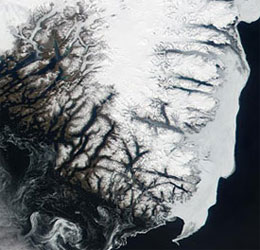Tremendous loss of ice in Greenland finds new NASA study
Tremendous loss of ice in Greenland finds new NASA study
mongabay.com
October 19, 2006
For the first time NASA scientists have confirmed that Greenland’s ice sheet is shrinking.
Using a new remote sensing technique that “reveals regional changes in the weight of the massive ice sheet across the entire continent”, researchers at NASA’s Goddard Space Flight Center found that Greenland suffered a net loss of 25 cubic miles (101 gigatons) of ice per year between 2003 and 2005.
“Greenland’s low coastal regions lost 155 gigatons (41 cubic miles) of ice per year between 2003 and 2005 from excess melting and icebergs, while the high-elevation interior gained 54 gigatons (14 cubic miles) annually from excess snowfall,” said the researchers in a release from NASA.
 Greenland’s massive ice sheet has lost nearly 100 gigatons of ice annually recently, much of it in low-elevation regions along the continent’s southeastern coast, including the southern tip (pictured here). Credit: NASA MODIS Land Rapid Response Team |
“With this new analysis we observe dramatic ice mass losses concentrated in the low-elevation coastal regions, with nearly half of the loss coming from southeast Greenland,” said lead author Scott Luthcke of NASA Goddard’s Planetary Geodynamics Laboratory. “In the 1990’s the ice was very close to balance with gains at about the same level as losses. That situation has now changed significantly, with an annual net loss of ice equal to nearly six years of average water flow from the Colorado River.”
The researchers say that new results show that Greenland is presently losing about 20% more mass than it receives from new snowfall each year.
“This is a very large change in a very short time,” said Zwally. “In the 1990’s, the ice sheet was growing inland and shrinking significantly at the edges, which is what climate models predicted as a result of global warming. Now the processes of mass loss are clearly beginning to dominate the inland growth, and we are only in the early stages of the climate warming predicted for this century.”
RELATED ARTICLES
Greenland’s ice continues to melt.
Data gathered by a pair of NASA satellites orbiting Earth show Greenland continued to lose ice mass at a significant rate through April 2006, and that the rate of loss is accelerating, according to a new University of Colorado at Boulder study.
Greenland’s ice melting rapidly. A new analysis of data from twin satellites has revealed that the melting of Greenland’s ice sheet has increased dramatically in the past few years, with much of the loss occurring primarily along one shoreline potentially affecting weather in Western Europe.
This article in based on a news release from NASA